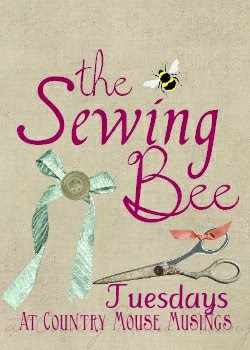This is part 2 of the “Handmade Life” series here at Sunny Patch. Today’s post involves sewing and creating for your home.
Sewing seems to be an art that is coming back to life as things become more and more expensive commercially. The quality of factory made things really seems to be heading down hill, and as soon as you purchase a piece of clothing or fabric based item, it needs mending or ravels or rips. Sure, there’s folks who will never get beyond the stigma of “homemade” items, but for the rest of the world who appreciates quality, a hand made high quality item is much better than the factory made.
This brings us to sewing for the home.
There’s many things in the home that are made of fabric that we can make ourselves. Think about what you use in the kitchen: potholders, apron, tea or dish towels, dish cloths, curtains/valances, etc. This is opportunity to not only save on expense, but also create a kitchen that suits your personality.
Today I’m focusing on potholders and aprons.
For the seamstress, making a potholder is probably one of the simplest projects one can do. In it’s simplest form, a potholder is batting or some sort of filler sandwiched between 2 pieces of fabric and stitched together. Of course this can be embellished, patched, made with just about any non-melting fabrics (second and third degree potholder burns just don’t sound too appealing, so use your cool polyesters for other projects).
Tipnut has a page of around 30 patterns just for potholders (free, I might add). So why not whip out some scraps or fat quarters and try a couple of patterns out. If you enjoy crocheting and/or knitting, this is a great time to break out some cool stitches and make your own potholders too! I like to make mine double thickness, using 2 strands of medium weight yarn and crochet. 🙂
Aprons are also a wonderful cost effective items to sew for your kitchen. Think about it–cooking can be messy. If it isn’t in your kitchen..are you enjoying what you’re doing???? LOL! I love my aprons, and really need to add more to my collection. My son Mr. Kevin has inherited a more “manly” one to use when he helps me in the kitchen (he’s my little cook in training–he has helped make pizza from scratch, and then here recently helped make cinnamon biscuits with Christmas cookie cutters). His apron gets flour all over it in under a second…perfect reason for him to inherit one. 🙂
Aprons are really easy to make. Seriously.
At it’s simplest, it’s a square with ties to go around the waist. At the more complex, it’s a fully covering garment that is as pretty as a beautiful dress. But, the overall idea is the same–to keep the clothing underneath from getting dirty and stained up from working in the kitchen.
My own aprons are a bit complex. I use pieces from the Country Cape Dress by Candle on the Hill to build mine. I use the cape part of the dress and half of the skirt, add ties and a snap and have a fully covering apron. Ok, it’s a little time consuming, but it works out for my purposes. I follow directions similar to the ones found at Shepherds Hill with modifications to tie in the back.
Wearing these, I honestly feel more feminine, as well as tend to get more work done. To me, this is a uniform. My job is to tend the house and work in the kitchen, why not have a uniform that goes along with that? I also tend to put an apron on first thing in the morning, and use it through out the day. It helps open up the oven and in a pinch when I can’t find the potholders it becomes the potholder. It keeps my clothes from getting totally soaked when doing the daily wash on the washboard and then doing dishes at the sink. It keeps my handmade clothing from getting stained up and covered in sauces and flour and cooking sprays when I cook our meals. And it makes a great hand towel when I can’t easily grab one and need it quickly to dry hands and catch the phone or help that child who has to have mom right now. In the garden during the spring and summer it becomes a make shift basket to hold freshly picked veggies.
The kids see me in my apron, and they seem more at ease. It’s like a comfort thing for them. They also know mom isn’t going anywhere when her apron’s on. They wait and watch for the apron to come off to see where I’m going…like maybe somewhere cool like the park or the store or something. 🙂
So, this is part 2 of the Handmade Life series…. I hope you’ve enjoyed a glimpse into our handmade life.. 🙂





































































